Delidding The AMD Ryzen 5 2400G APU: How To Guide and Results
by Gavin Bonshor on May 10, 2018 8:00 AM EST- Posted in
- CPUs
- Guides
- APUs
- Ryzen
- Ryzen 3 2200G
- Ryzen 5 2400G
- Delidding
- Delid
Delidding The AMD Ryzen 5 2400: Preparing The APU For Use
Now that the Ryzen 5 2400G has been successfully delidded without any damage, it is now time to prepare the Ryzen 5 2400G ($169) for use; in our case, on the test bench to see what/if there are any thermal benefits of changing the stock paste applied, as well as available overclocking headroom as a result of this process.
Step 9 – Removing the Glue from the IHS and CPU
The next step is to remove the black glue that was holding the IHS to the CPU package. Both the CPU package and the IHS is likely to have this glue, as a delid is often not a clean separation. The picture above shows the black stuff.
Not only does the included acrylic adapter with the Delid Die Mate 2 AMD kit act as a layer of protection for the CPU pins on the Ryzen 2000 series APUs, but as the acrylic itself is softer than silicon, it can be used safely to remove the glue from both the IHS and chip.
Step 10 – Cleaning The APU
It’s a good idea once the glue has been removed and scraped from the IHS and APU, that both surfaces are cleaned to remove any residue from the thermal paste and glue themselves. A single alcohol wipe comes included with the Thermal Grizzly Conductonaut Liquid Metal ($16) which is good as it will remove all traces of thermal paste from the die.
Step 11 – Applying Liquid Metal Thermal Paste to the Die and Heat Spreader
Once both surfaces are clean, it’s time to update the TIM. The best user-applicable TIM is based on liquid metal: a compound designed to embed and fuse itself between the CPU die and the heat spreader. For our testing, we use Thermal Grizzly Conductonaut, designed especially for this use case, however others are available (such as CoolLaboratory LIQUID Pro).
As per the instructions, apply a liberal amount of the liquid metal to both the IHS and the die. The trick is to start with a small amount and use the included black Q-tip provided to patiently spread the liquid metal across the surface. Only the die surface area needs covering and this is important as liquid metal is highly conductive and if any were to get on any of the other components around the silicon die of the chip, it’s likely to short out and die making the whole process futile and fruitless.
Liquid metal can be tricky to use and apply, but the method is to be persistent as takes a little bit of time for the liquid metal to stick, but once it does, it’ll start spreading much easier. The key is to start small, slowly and most importantly, carefully when applying liquid metal. Another caveat is using too much: if you use too much, when you place the heat spreader back on the CPU, the excess will escape due to the pressure. If this happens and it touches the other components, when powered on it will short out and most likely fry your chip. If you have lots of dark puddles, you can simply use the Q-tip to remove excess or if you manage to get it around outside of the raised section of the IHS or on the SMDs, pure acetone (not containing aqua) is the easiest method of removing it.

Nearly ready, some excess liquid metal needs removing before adding the IHS
Step 12 – Adding the Heat Spreader and Installing the APU In the Socket
The best way of applying the liquid metal to the die of the Ryzen 5 2400G (or Ryzen 3 2200G) is doing it while the processor is out of the socket. This is to avoid any mishaps during application as liquid metal can be a very horrible substance to remove, although using acetone works wonders. The next step is placing the IHS back onto the heat spreader with as little movement once it is in place as physically possible. When delidding Intel processors that use a lane grid array socket such as LGA 1150 or LGA 1151 is the socket has a retention bracket which holds the IHS down in place; AMD PGA sockets do not have this function.
Some users can also apply a new silicon glue around the edge of the IHS to connect it to the package. This can make this stage of the process easier, however it does add additional height to the overall chip, potentially making the new TIM less effective.
Step 13 – Installing the CPU Cooler with Care, Precision and Patience
While the thought of delidding a CPU is daunting, for me personally, the hardest part when delidding an AMD Ryzen 2000 series APU is safely installing the CPU cooler without breaking that seal of liquid metal between the die and IHS. One wrong jerk could or misplacement could get liquid metal on one of the SMDs unknowingly which wouldn’t be visible until it was too late. After applying standard thermal paste between the IHS and cooler, while keeping the IHS straight, it’s a good idea to place the cooler on top without applying too much pressure but lining it up with the mounts so that the tightening applies the pressure as opposed to using body weight.
The cooler for our AMD motherboard test setup is the Thermaltake Floe Riing RGB 360 AIO which is considered as a high-performance CPU cooler and should in theory, provide a nice reduction in temperatures over non-delidded; the rationale is that the better the cooler, the lower the temperatures. When attaching the cooler to the APU and motherboard, I found placing it on top gently and centered worked well, while simultaneously screwing in two of the thumbscrews in a diagonal method to each other at the same time. This applies even amounts of pressure, or as even as you’re going to get to ensure the liquid metal isn’t disturbed too much. Installing the other two thumb screws finishes the installation process.
The most important attributes to take into consideration throughout the whole process when delidding a CPU/APU and installing is patience and care. TAKE YOUR TIME - it is not a sprint, but a marathon and one slight mistake can kill a chip.


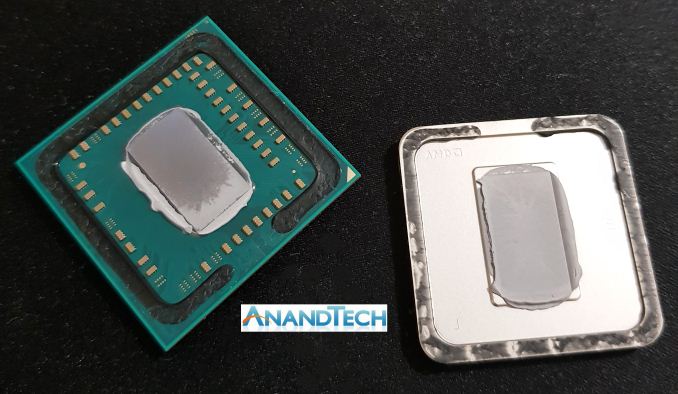
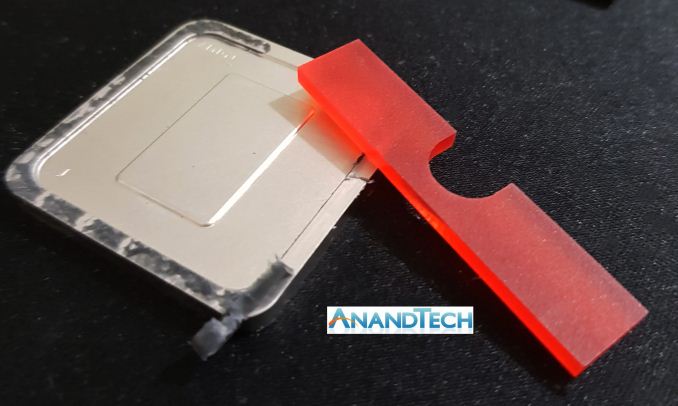
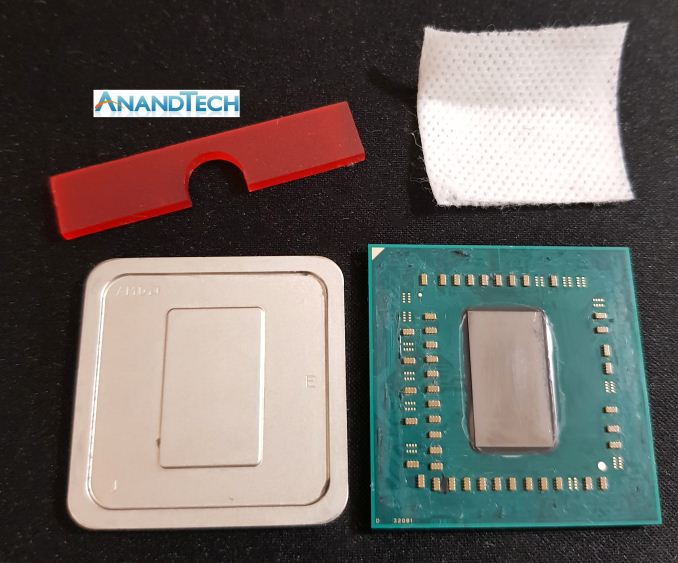
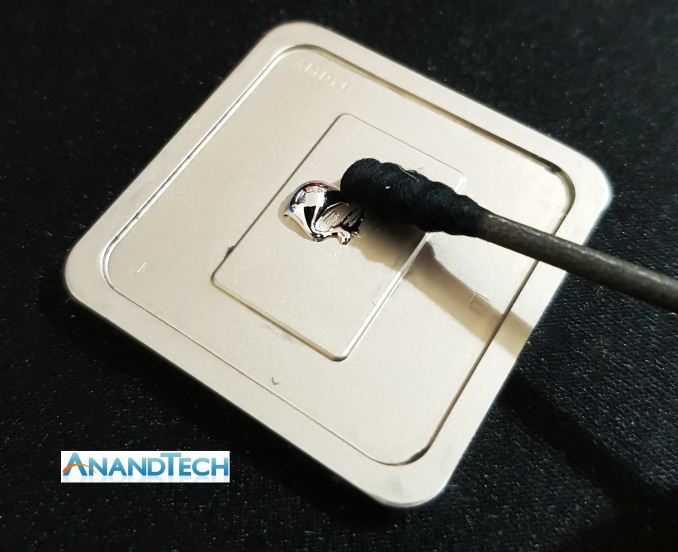
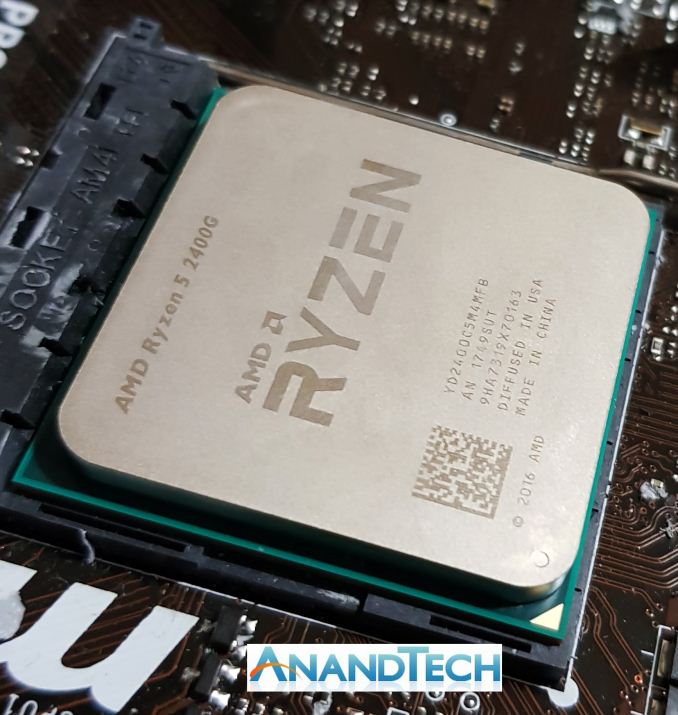
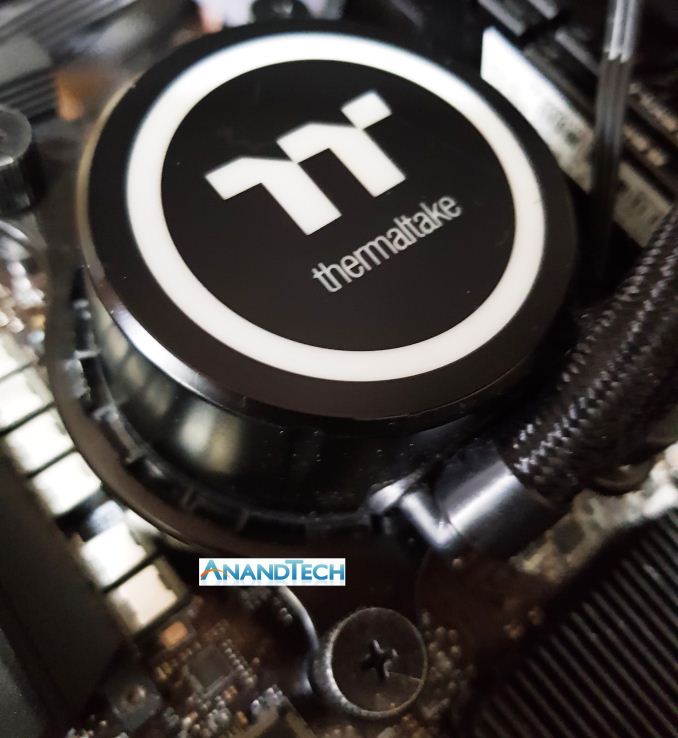








73 Comments
View All Comments
Ian Cutress - Thursday, May 10, 2018 - link
AMD does use solder on the Ryzen CPUs. It's the APUs that have paste. They do market the Ryzen-2000 CPUs as having higher-grade Indium-Tin solder.eastcoast_pete - Thursday, May 10, 2018 - link
Hi Ian, I should have been more precise: it's exactly because AMD "does the right thing" and uses solder for its non-APU Ryzen 2000 chips that this use of paste sticks out. I wish they would do so also for their Ryzen APU lines. Would make anyone considering buying a 2200G or 2400G feel less like a second - class customer, and emphasize the perception that this is a premium productOxford Guy - Thursday, May 10, 2018 - link
"Would make anyone considering buying a 2200G or 2400G feel less like a second - class customer, and emphasize the perception that this is a premium product"Intel hasn't had much trouble convincing people to spend a lot more on its second-class customer CPUs. It has been selling quite a lot of them since Sandy.
werpu - Wednesday, May 16, 2018 - link
Well the article was exaggerating the problem. There nowhere was a package difference of 12c in their numbers, as far as I remember in the upper area of 4.1 GHz it was 9c (from 67 down to 58). Sure they got another 100MHz out of it, but that is playing the silicon lottery area.So in reality depending on your workload the difference between the liquid cooling method and the a stock cooling via the usual ways is 4-9 degrees. This is not worth it. They might have shaved off 2-7 degrees by going full solder, but we are talking about cheap apus here. This is not an Intel like situation where the difference often is in the 15-25c degrees range due to cheap stuff being used.
Lolimaster - Thursday, May 10, 2018 - link
Why techsites and techtoubers don't understand, temps is not what is holding Ryzen or Ryzen APU's, is the way they designed the 1st iteration for a mobile oriented node.OCing the cpu part of the APU is WORTHLESS when the base clock is already 3.6Ghz, without delidding, any 2400G will do 1500Mhz+ on the gpu (good ones 1700 @1.3v for the soc voltage, the max for safety)
The benefit for delidding the APU is basically lower temps, specially when using the stock HS or a low profile one.
eastcoast_pete - Thursday, May 10, 2018 - link
Agree. I am eagerly awaiting a GPU-only overclock article for these, both stock and delidded. Also, second the interest in seeing that comparison with the stock cooler. My main interest in these (especially the 2400G) is the price/value aspect, and I don't think that many will want to shell out well over 100 Euros or dollars for a fancy cooler.gavbon - Thursday, May 10, 2018 - link
There will be a iGPU scaling piece, it is in the pipeline, along with CPU frequency scaling and memory scaling on APU, iGPU and dGPUDiji1 - Friday, May 11, 2018 - link
>the way they designed the 1st iteration for a mobile oriented node.Hopefully that means we'll see some tablets with 3D gaming possibilities then!
Matt G - Thursday, May 10, 2018 - link
Great article. Was an interesting read but FYI: If you add the cost of all the parts it totals $247 dollars. For that price you could easily step up to a much faster Ryzen 7 1700 for the same price.Ian Cutress - Thursday, May 10, 2018 - link
Therein is the rub, unless you know someone with a delidding tool. But hey, people buy $2000 cars and spend $10k in mods.